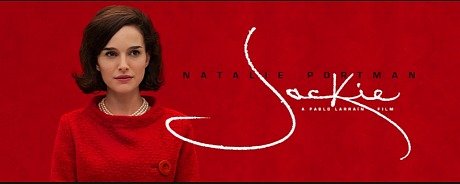Click here to jump past HE Sink-In


Life can be hard and cruel and sometimes shattering, but few have ever had to cope with the kind of mind-numbing horror that slapped Jackie Kennedy across the chops on 11.22.63. And then she had to carry the weight for everyone, the weight of that whole terrible four-day pageant, and somehow the after-vibes have never quite gone away, even with the passing of 53 years. Ask anyone who was over the age of ten back then (i.e., boomers who are now over 60) and they’ll tell you all about that day, that pall, that weekend, that ache-athon that was broadcast morning, noon and night for over 80 hours straight.
It was therefore brilliant and kind of brash for Pablo Larrain to avoid the usual-usual in the making of Jackie — to sidestep that mass memory and not deliver a rote recap of what Mrs. Kennedy, only 34 at the time, went through that weekend, but to make a kind of art film — to give her portrait a kind of anxious, fevered, interior feeling. And yet it’s a saga of strength and steel — a woman who held it together and led a nation.
Larrain called for a rewrite of Noah Oppenheim‘s original 2010 script, cutting out many if not most of the well-known figures who had speaking parts and pruning Jackie down to what it is now — intimate, half-dreamlike, cerebral, not entirely “realistic” but at the same time persuasive and fascinating.
The film works, of course, because of Natalie Portman‘s performance — pretty much its own bird, and unlike any of this type ever seen. Toronto Globe and Mail critic Barry Hertz said it nicely on 12.9: “To watch Portman’s every move is to not only watch history being recreated, but to also witness history being made. No one will ever be able to touch this role again. Or, at least, no one should.”
Almost all of Jackie is shot in close-ups, right in there, no blinking or downshifting.
And the music! Mica Levi‘s melancholy strings, not so much “melodic” as a kind of melodic wailing. It’s the first thing you hear as the film begins, and it sinks right in, sets the tone for the whole film. The strings and a couple of tracks from the original B’way cast album of Camelot comprise the entire musical scheme.
Not even those haunting funeral drums are heard — a ballsy move when you think about it.
Shot in 16mm and projected at HE’s favorite aspect ratio of 1.66:1, Jackie is not a song re-sung but refreshed — a “cover” if you will. Like any work of art Jackie is primarily about the vision and the brushstrokes and secondly the subject. It’s about how Pablo, Natalie, Jackie, Bobby and Jack have somehow spliced their DNA and made something new and now, and at the same time delivered a spooky time trip.
Jackie is therefore more about Portman playing Jackie than the former First lady herself, although Portman has not only recreated the voice and the mannerisms and the sadness but has sunk right into the minutiae of that life and those times.
90% of the events of the film are flashbacks, conveyed as Mrs. Kennedy is interviewed in late ’63 by a composite character roughly based on historian Theodore H. White. Billy Crudup‘s portrayal of White is the film’s second best performance. He hits exactly the right notes, speaking to the former First Lady concisely, frankly, tactfully.
Hertz again: “Larrain uses Portman’s towering talent to paint an epic, all-consuming portrait of grief — an extraordinary, lacerating submersion into the darkest corners of a person’s life that is both relatable and alluringly unknowable.
“Mercifully, this is no mere biopic. We never learn about Jackie’s upbringing or her family history of her courtship with Jack. We never flash-forward to her later years, with someone thinking it was a good idea to cake Portman with old-age makeup and pretend it looked all very natural. In Jackie, we only witness the woman just before or just after the death of her husband. By constantly shifting the narrative between her life pre- and post-assassination, Larrain builds up the dream of Camelot before tearing it down, over and over again. There’s Jackie dancing with Jack in the White House. And then there’s Jackie in the shower, washing off the blood of her husband.
“It’s a devastating technique, one that only as brave and uncompromising a director as Larrain would employ.”












